Pelargonium thyroid: the best varieties and tips for growing
Pelargonium or among the people, geranium is the favorite of many gardeners. It differs in a huge number of varieties and species. One of the types is the thyroid (ivy) beauty. It differs from other geraniums in that it has a beautifully outlined leaf, with a glossy surface.
The plant is represented by a large number of shrubs with original colors. But, having chosen a separate shrub and planting it in a flowerpot or in an open area, you should know about the growing conditions and care recommendations.
Content:
- Indoor plant description
- The best varieties
- Growing conditions
- Breeding methods and planting
- Care advice
- Everything you need to know about a transplant
- Diseases, their signs and methods of treatment
- Pests, their signs and control of them
Indoor plant description
Pelargonium thyroid is an interesting flower with creeping vines, thin in structure, but strong enough. Shoot length with good care can reach 70-100 cm.
At first glance, they are easy to break, but if you get down to business, then carrying out this process is quite problematic. In order not to injure the plant, it is recommended to cut it with a sharp pruner or garden shears.
Pelargonium has five-lobed fleshy leaf plates. In color, the foliage has a rich green, light green or variegated tone. The homeland of the shrub is South Africa. The plant loves to grow in high humidity and abundance of sunlight. If these conditions are implemented, then the bush will delight with its flowers from early March to late autumn days.
Peduncles are formed in the axils between the leaf cuttings and the main trunk.
The arrow tends to stretch out 7-10 cm, at the end of which a significant number of inflorescences are formed. When the buds open, a huge, bright ball forms.
Ivy Pelargonium is a flower with various colors, both delicate shades and bright, flashy:
- White
- Pink
- Red
- Burgundy
- Velvet black
- Lilac
- Raspberry
- Bicolor
- With veins around the entire perimeter of the flower
Each of the flowers is up to 1.5-2.5 cm in diameter, and some large-flowered geraniums boast a single flower up to 4 cm in size. In this case, geraniums differ not only in the shade of the flowers, but also in the structure of the inflorescence. It can be terry or simple. In most cases, gardeners grow geranium in the form of an ampelous shrub in hanging flower pots or pots. In this case, long shoots hang beautifully from the pot, attracting the eye with their bright inflorescences of flowers.
The best varieties
There are only 75 species of pelargonium in wildlife, which differ in color, leaf shape and bush structure. Modern breeders from different parts of the world have made a huge contribution to the development of species varieties.
There are over 500 collectible and industrial cultivators on the industrial market.These geraniums are conditionally divided into two large subgroups - independently ivy geraniums and ivy hybrids (ivy hybrids).
On the Russian market, only two varieties can be found in the form of seeds:
- Summer Showers (Summer Showers) is the first F1 hybrid grown from harvested seeds. A mixture of seeds of this species can include colors of red, pink, scarlet, wine, lilac and white. The shape of the inflorescence is not terry, simple. The diameter of the inflorescence can reach up to 7 cm in diameter. Differs in stems of a large, strong structure, which do not require pinching. They branch out on their own, reaching their maximum length.
- Summertime - differs in a set of 5 colors. The vine is of medium length, the inflorescences are not terry. Differs in long flowering. After the seedlings have been planted and the geranium has begun to grow, the first flowers may appear in 4.5 months.
A much larger selection of ivy geraniums is represented by rooted cuttings or grown bushes. In large nurseries or specialty stores, you can find different varieties, such as:
- A series of varieties Corriente - represented by a large number of different flowers with semi-double inflorescences. This variety includes bicolor inflorescences. The varieties of this group include: Arctic Red, Burgundy Two-color, Pink Spirit, Amethyst, Ragtime, Mexicanerin, Luna, Beach, Reggie Red.
- Blizzard varieties - endowed with very large inflorescences, but not terry in shape. Shoots reach considerable length, branch well. The buds appear in early spring and bloom until late autumn. The species include the following varieties: White, Pink, Red (pink-scarlet), Dark Red (burgundy), Blizzard Blue (lilac shade).
- A series of Tempano varieties - small-sized shoots on which foliage is located close to each other (compact). Flowering begins early, the flowers bloom semi-double, bright juicy tones with an abundant release of buds (Orange, Maxim, Blanche Roche, Orcid, Molina, Butterfly, Flair, Marimba).
- Variety Cascade - has long climbing shoots and peduncles with a simple shape of inflorescences. (Compact Pink, Leela, Fire, Ville de Paris, Acapulco, Somon).
- Giant species - it is realized only in the form of rooted seedlings and has only 3 varieties: Bicolor (pink-white shade with a red edging along the edge of the petal), White (semi-double-shaped white shade) and Fire (red-brick color).
Growing pelargonium is not difficult if you know all the nuances and rules and try to follow them methodically. Geranium will respond with frequent and long flowering and rapid growth of bright glossy shoots.
Growing conditions
Geranium is unpretentious, so good lighting and periodic maintenance are its main requirements. For cultivation, you will need to transplant it to a permanent residence in a separate flowerpot immediately after purchasing the cuttings.
For quality growth, nutritious, loose soil is needed. It is desirable that the soil is initially fertile with a neutral pH environment. Otherwise, if the soil is acidic or alkaline, geraniums will not be able to develop normally and will sit in one place. Flowering begins in early spring, so watering is carried out as needed. In autumn, it is recommended to slightly reduce the introduction of moisture into the soil.
Let the pelargonium rest for optimal spring-summer flowering.
To do this, it is recommended to eliminate all feeding, reduce the temperature to 12-150C and put it in a place with sufficient sunlight. Moreover, if pelargonium feels a lack of light, its shoots will begin to quickly stretch and shrink. Therefore, experienced gardeners are advised to reduce the vine to a maximum of 20-30 cm.
Breeding methods and planting
Planting is carried out in a pot, which is specially selected for a certain type of geranium. If they ate geraniums from the ampelous type, it is recommended to choose a larger flowerpot.Otherwise, if pelargonium is represented by a compact variety, then the container does not need an oversized one.
If planting is carried out directly into open ground, then the planting hole should be 20 cm deeper than the rhizomes.The distance between the bushes must be left at least 30-40 cm.
Pelargonium propagation occurs in two ways: cuttings and sowing seeds. In the latter case, sowing seeds can be started from the first decade of December to the last days of April. But this growing process is possible if there is a possibility of additional highlighting in winter.
Features of seed reproduction:
- The seeds are placed in pre-prepared and well-moistened soil. Seeds are laid out to a depth of no more than 5 mm.
- With significant deepening, the sprout will take a long time to break into fresh air or rot.
- After planting, the seedlings are placed in a mini-greenhouse or covered with a plastic bag to create favorable conditions.
- Seeds germinate at a temperature of +22 .. + 24 C. The first shoots appear within 7-10 days after planting.
- When growing, watering should be carefully controlled - excessive moisture or insufficient irrigation threatens death.
- 3 weeks after the appearance of the first sprout, bushes dive for permanent residence.
- After that, you can start feeding the geranium in small doses, stimulating it to develop rapidly.
For cultivation by cuttings, it is necessary to obtain high-quality seedlings. For this:
- A strong shoot is cut from the mother bush with a sharp knife or pruner, necessarily disinfected.
- Pruning is carried out in the last days of summer, when the shoots are gaining the greatest amount of nutrients from the soil. Pruning can be carried out not only at the end of summer, but also in spring from overwintered bushes.
- The stalk should be no more than 7-10 cm in length. It is placed before rooting in a special solution that stimulates the formation of roots. Only then should the prepared seedling be placed in fertile soil.
- Greenhouse conditions should not be reproduced. This is due to the fact that with strong soil moisture, a fragile stalk without root system can easily rot.
- Plantings with cuttings are placed in a warm, sunny room with a moderate temperature regime.
The first rhizomes appear within 3 weeks. After 2-3 months, the seedlings can be transplanted to a permanent place of residence.
Care advice
In order for geranium to develop well and quickly, it is recommended to follow certain care rules:
- Watering - it is necessary to irrigate the plant periodically, avoiding significant overflow. But it is also not worth starting and significantly drying the soil. If the plant is poured, then the root collar of thyroid pelargonium can quickly rot and the plant can die. If the temperature in the room is significantly high or the bush is on the windowsill, next to the heater, then watering should be carried out every day. Otherwise, when the bush is in other conditions, it is recommended to observe the earthen lump, but avoid excessive drought.
- Humidity - the plant is neutral to air humidity, therefore it does not require irrigation of the leaves.
- Lighting - it is necessary to place shrubs on sunny sides, preferably on the south. The bush is not afraid of abundant burning sun rays, on the contrary, if you shade foliage and flower stalks for a long period, then the latter will be faded and inconspicuous.
- Air temperature - the optimal temperature for good growth is considered to be +20 .. + 26 C in summer and +12 .. + 15 C in winter. But in winter, it is recommended to keep the plant in a cool climate. This is due to the fact that the bush, having fully rested, will bloom profusely in such conditions in the summer.
- Fertilizers - top dressing begins to be applied during the growing season, starting from the moment of flowering. Fertilize plants with high nitrogen and potassium supplements, micronutrients and organic ingredients. But you do not need to over-apply nitrogen-containing fertilizing, they can provoke abundant growth of greenery, instead of lush flowering.
Thanks to the fulfillment of the rules, the shrub will grow for a long period, develop magnificently and delight not only with bright colors of inflorescences, but also with massive, strong stems.
Everything you need to know about a transplant
Both adults and young plants need to be replanted annually. The procedure is recommended to be carried out in the spring, before the beginning of the growing season. In the spring, mature plants should be transplanted into a larger flowerpot. This is necessary due to the fact that the root system of the thyroid pelargonium significantly branches and draws all the nutrients from the soil, significantly depleting it.
But do not overdo it with a flowerpot. If you plant a plant in a flowerpot much larger in volume, then pelargonium will begin to develop the root system in place of the ground part. Until the rhizomes completely fill the entire flowerpot, the shrub will not start growing. Transplantation of thyroid pelargonium must be carried out by transshipment. To do this, it is necessary to slightly moisten the soil in the flowerpot, so that you can easily pull out the clod of earth from the flowerpot. If possible, the earth is slightly shaken off the bush, but so as not to injure the root system.
Expanded clay or other drainage is laid out at the bottom of the flowerpot.
It is necessary so that nutritious moisture does not stagnate in the flowerpot, provoking root rot. After that, a small layer of fresh soil is poured. A plant is placed on top of it. Fresh fertile soil is poured from the sides and top.
The substrate needs to be lightly tamped. It is imperative to ensure that no hollow holes form in the soil. After transplanting, the plant should be well watered. Old pelargoniums are not transplanted, fresh soil is added to them without transplanting. This is done by adding the soil mixture after the top depleted layer has been removed.
Diseases, their signs and methods of treatment
In most cases, pelargonium thyroid and its varieties are resistant to various kinds of diseases and pests. But in some situations, they can be affected by the following diseases:
- Yellowing of deciduous plates is not a disease, but a consequence of improper care. To return the flowering geranium, the plant should be abundantly watered with nutritious moisture and fed, while all yellow leaves should be removed.
- Lack of flowering is also the result of improper care. The lack of peduncle formation can be triggered by improper lighting, lack of a dormant period, insufficient watering, or dim lighting. To remove a plant from such a state, it is necessary to revise the rules for caring for a houseplant.
- Fungus Botrytis - gray spots with fluff form on the leaf plates. The plant becomes lethargic, lifeless. On the shoots, brown foci of rot are formed, which can spread to the entire shrub and provoke the death of the plant. To eliminate the fungal disease, it is recommended to replace the soil near the shrub, to periodically loosen the soil. Remove all damaged areas of geranium and spray with chemical insecticides.
- Root rot - the root system rotting, provokes yellowing of the leaf plates, a whitish bloom forms on the surface of the leaves. To eliminate the disease, you should periodically loosen the soil substrate, remove all diseased stems and leaves, and eliminate the existing inflorescences. Remove all nitrogen fertilizers and spray with chemicals.
- Rust on the sheet - characterized by the appearance of rust spots on the sheet plates. Prolonged lack of treatment leads to the formation of blackening in places of rust. It is possible to cure the disease only at the first stages of the disease, irrigating with special chemicals.
If you follow the plant and detect a dangerous disease in time, then it will not be difficult to cure pelargonium. But if the bush is heavily infected, it is recommended to urgently resort to either intensified control actions using chemicals, or to take cuttings and grow a new healthy plant.
Pests, their signs and control of them
Pelargonium does not differ significantly from other plants and is affected by various pests during the growing season. There are the following parasitic individuals that love to settle on juicy fleshy geranium leaves:
Their general signs of appearance on a plant do not differ from settling on other shrubs and flowers. To fight, you need to monitor your own houseplant and, if an insignificant amount of parasites appear, manually eliminate it by carefully examining the plant. Additionally, you can apply folk remedies.
Otherwise, if the population has crossed the acceptable limits, the only way to cope with the problem is to use chemicals.
Thus, the thyroid pelargonium or ivy geranium is an original bright plant that attracts the eye not only with its lush flowering, but also with its specific foliage. In order for the shrub to develop quickly, it is necessary to follow the growing rules and monitor the care, although the plant does not require specific conditions, lack of care leads to the occurrence of diseases and parasites.
More information can be found in the video:



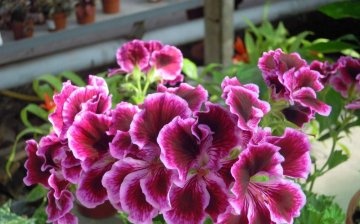

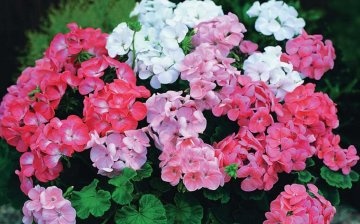
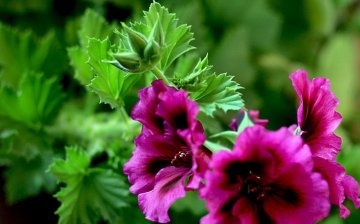
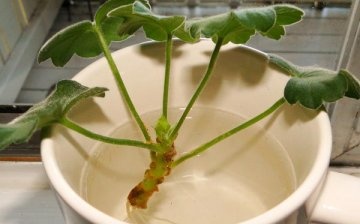
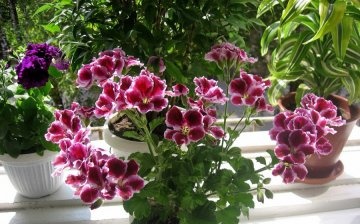
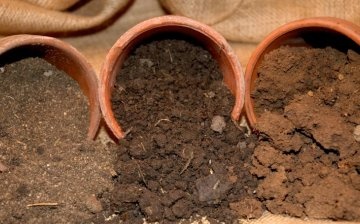

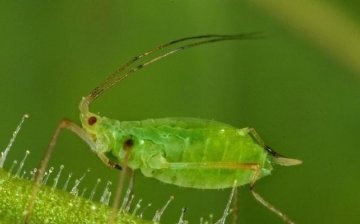









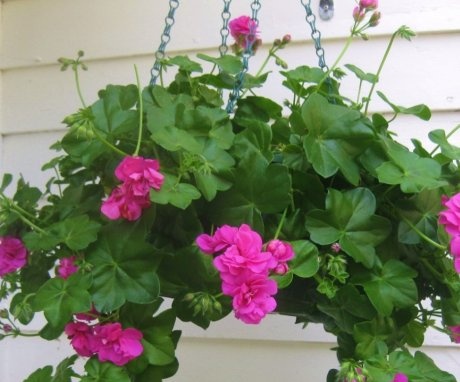

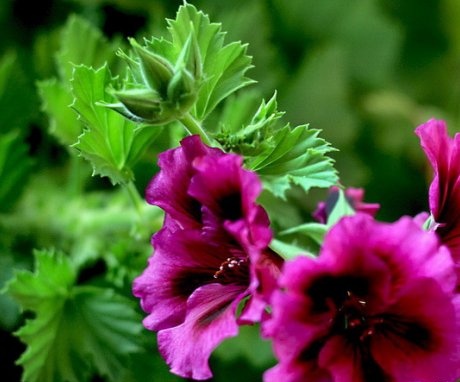
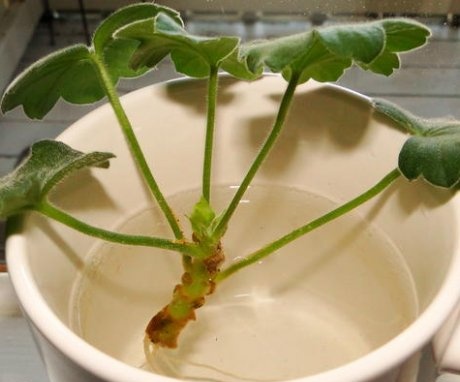

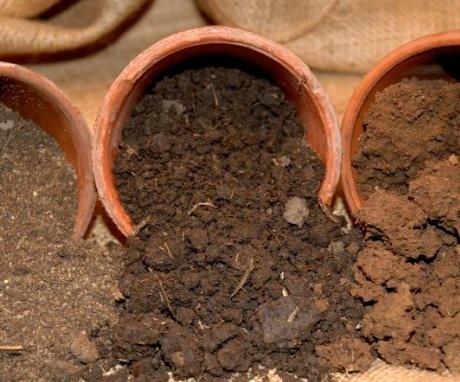

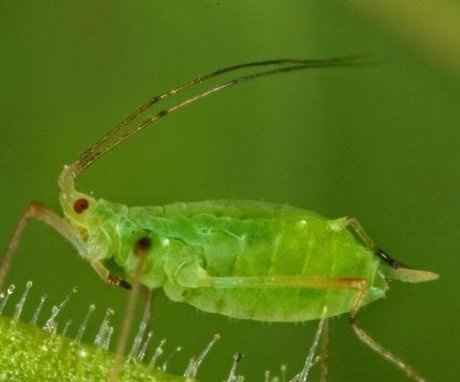
I really like to grow these flowers on the balcony in the summer, for the winter I clean them in the barn between the floors. They tolerate dry air in the apartment rather hard. And from spring to autumn they delight me with their flowering.